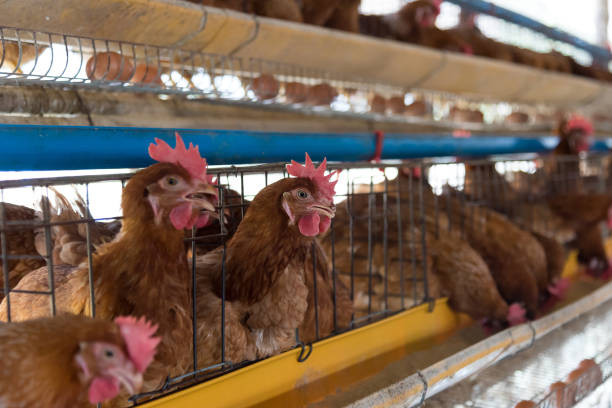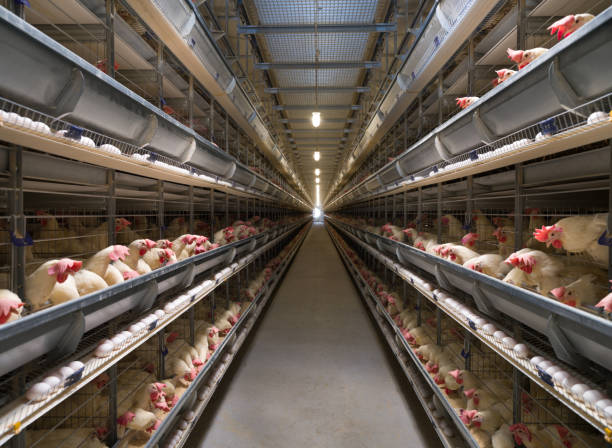
Cost-Effective Broiler Cage Solutions for 10,000 Birds in Africa
Cost-Effective Broiler Cage Solutions for 10,000 Birds in Africa
For poultry farmers in Africa looking to maximize their broiler production, finding cost-effective solutions without sacrificing bird welfare and efficiency is paramount. Raising 10,000 broilers is a significant undertaking, demanding careful planning and investment in appropriate equipment. Broiler cages, when implemented correctly, can be a game-changer, offering a high-density rearing environment that can significantly boost profitability. However, navigating the options and selecting the right caging system can be daunting. This article breaks down the key considerations for establishing a cost-effective broiler cage setup for 10,000 birds in Africa, focusing on cage types, size specifications, materials, environmental control, feeding and watering systems, waste management, biosecurity, operational costs, and return on investment.
**Understanding the Benefits of Broiler Cages**
Before diving into specifics, it’s crucial to understand why broiler cages are gaining popularity among poultry farmers. Comparing them with traditional deep litter systems highlights their advantages.
First and foremost, broiler cages promote higher stocking densities. By utilizing vertical space, farmers can house more birds in a smaller area compared to floor rearing. This leads to lower land costs and more efficient use of available resources.
Secondly, cages facilitate better hygiene and disease control. The separation of birds from their droppings reduces the risk of coccidiosis and other common poultry diseases. Manure collection is also simplified, contributing to a cleaner and healthier environment.
Thirdly, broiler cages improve feed conversion rates. Birds in cages tend to be less active than those on the floor, meaning they expend less energy on movement and more on growth. This translates to lower feed consumption per kilogram of meat produced.
Finally, cages contribute to efficient management. Automated feeding and watering systems reduce labor requirements, while easier bird monitoring allows for early detection of health problems.
**Choosing the Right Type of Broiler Cage**
Several types of broiler cage systems are available, each with its own advantages and disadvantages. The most common types include:
* **A-Frame Cages:** These are traditional cage systems with cages arranged in an “A” shape. They are relatively simple and inexpensive to install, making them a popular choice for smaller-scale operations.
* **H-Frame Cages:** These systems have cages arranged in an “H” shape, offering better space utilization and improved ventilation compared to A-frame cages. They are suitable for larger flocks like 10,000 birds.
* **Stacked Cages:** These systems consist of multiple tiers of cages stacked on top of each other, maximizing space utilization. Ideal for farms where land is limited, but may need additional climate control modifications.
For a 10,000-bird operation in Africa, H-frame or stacked cage systems are often the most appropriate choices due to their superior space efficiency and scalability. The decision will depend on specific farm layout and budgetary constraints.

**Cage Size and Specifications: Ensuring Bird Welfare**
Cage size is critical for bird welfare and overall productivity. Overcrowding can lead to stress, decreased growth rates, and increased disease susceptibility. It’s essential to adhere to recommended stocking densities:
* **Space per bird:** Generally, aim for approximately 450-550 square centimeters of floor space per bird. This translates to about 10-12 birds per square meter.
* **Cage Dimensions:** For 10,000 birds, you’ll need to calculate the total cage area required based on the desired stocking density. The dimensions of individual cages will influence the overall layout and design of the poultry house. It’s advisable to consult with a poultry equipment supplier, like Livi Machinery, to determine the optimal dimensions and layout for your specific needs.
* **Cage Height:** Adequate cage height is required for birds to stand comfortably. A minimum height of 30-35 cm is recommended.
**Material Considerations: Durability and Longevity**
The materials used in the construction of broiler cages play a significant role in their durability, hygiene, and overall cost-effectiveness.
* **Galvanized Steel:** Galvanized steel is the most common material for constructing broiler cages due to its strength, corrosion resistance, and relatively low cost. Hot-dip galvanization provides better protection than electro-galvanization.
* **Welded Wire Mesh:** High-quality welded wire mesh is essential for the cage floor and sides. Choose a mesh size that prevents birds from getting their feet caught but allows for easy manure passage.
* **Plastic Components:** Plastic materials are often used for water troughs, feed troughs, and other cage components. Opt for durable, food-grade plastics that are easy to clean and disinfect.
**Environmental Control: Maintaining Optimal Conditions**
Maintaining a stable and comfortable environment within the poultry house is crucial for broiler health, growth, and feed conversion.
* **Ventilation:** Adequate ventilation is essential for removing stale air, ammonia, and excess moisture. Natural ventilation can be sufficient in some areas, but mechanical ventilation (fans) is often necessary, especially in hot and humid climates. Consider using exhaust fans, tunnel ventilation, or a combination of both.
* **Temperature Control:** Broilers are sensitive to temperature fluctuations. Maintaining a consistent temperature range is essential for optimal growth. In hot climates, cooling systems such as evaporative coolers, fogging systems, or shade cloths may be necessary. In colder climates, heating systems may be required.
* **Lighting:** A well-designed lighting program is crucial for stimulating growth and improving feed conversion. Provide adequate light intensity and duration, following a consistent schedule. Consult with a poultry expert to determine the optimal lighting program for your specific breed and production goals.
**Feeding and Watering Systems: Ensuring Adequate Nutrition**
Efficient feeding and watering systems are essential for providing broilers with adequate nutrition and minimizing feed wastage.
* **Automatic Feeding Systems:** Automatic chain feeding systems or pan feeding systems are commonly used in broiler cages. These systems deliver feed evenly to all birds, reducing competition and waste.
* **Nipple Drinking Systems:** Nipple drinkers provide a clean and consistent water supply, reducing the risk of contamination. Sufficient drinkers should be placed within each cage to ensure that all birds have easy access to water.
**Waste Management: Maintaining Hygiene and Reducing Odors**
Efficient waste management is essential for maintaining hygiene, reducing odors, and preventing disease outbreaks.
* **Manure Collection Systems:** Manure collection systems can range from simple manual scraping to automated belt systems. Automated systems are more efficient and require less labor.
* **Manure Storage:** Proper manure storage is essential for preventing environmental contamination and reducing odors. Manure should be stored in a dry, covered area away from water sources.
**Biosecurity Measures: Protecting Your Investment**
Biosecurity is paramount for preventing disease outbreaks and protecting your investment.
* **Strict Hygiene Protocols:** Implement strict hygiene protocols, including regular cleaning and disinfection of the poultry house and equipment. Control access to the farm and require visitors to wear protective clothing.
* **Vaccination Programs:** Implement a comprehensive vaccination program to protect against common poultry diseases. Consult with a veterinarian to determine the appropriate vaccination schedule for your region.
* **Rodent and Pest Control:** Implement a comprehensive rodent and pest control program to prevent disease transmission and feed contamination.
**Operational Costs: Minimizing Expenses**

Running a broiler farm involves various operational costs, including feed, labor, electricity, water, and veterinary expenses.
* **Feed Costs:** Feed typically accounts for the largest portion of operational costs. Optimize feed conversion rates by providing balanced feed rations and maintaining optimal environmental conditions.
* **Labor Costs:** Automation can help reduce labor costs. Consider investing in automated feeding, watering, and manure collection systems.

* **Energy Costs:** Energy costs can be significant, especially in hot or cold climates. Implement energy-efficient lighting, ventilation, and cooling systems.
**Return on Investment: Assessing Profitability**
Before investing in a broiler cage system, it’s essential to assess the potential return on investment (ROI).
* **Production Efficiency:** Broiler cages can improve production efficiency by increasing stocking densities, improving feed conversion rates, and reducing mortality rates.
* **Market Prices:** Monitor market prices for broilers to determine potential revenue.
* **Cost Analysis:** Conduct a thorough cost analysis to determine the total investment required and the expected operational costs.
By carefully considering these factors, you can determine whether a broiler cage system is a cost-effective solution for your 10,000-bird operation in Africa.
**Working with Livi Machinery**
Livi Machinery specializes in providing poultry equipment for African farmers. We understand the unique challenges and opportunities in the region and offer tailored solutions to meet your specific needs.
Our broiler cage systems are designed for durability, efficiency, and bird welfare. We offer a range of cage types, sizes, and configurations, as well as automated feeding, watering, and manure collection systems.
Our team of experts can help you design and install a cost-effective broiler cage system that maximizes your profitability while ensuring the health and well-being of your birds. Contact us today to learn more about our products and services.
